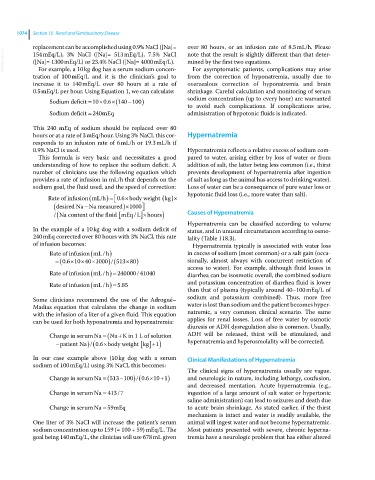Page 1136 - Clinical Small Animal Internal Medicine
P. 1136
1074 Section 10 Renal and Genitourinary Disease
replacement can be accomplished using 0.9% NaCl ([Na]= over 80 hours, or an infusion rate of 8.5 mL/h. Please
VetBooks.ir 154 mEq/L), 3% NaCl ([Na]= 513 mEq/L), 7.5% NaCl note that the result is slightly different than that deter-
mined by the first two equations.
([Na]= 1300 mEq/L) or 23.4% NaCl ([Na]= 4000 mEq/L).
For example, a 10 kg dog has a serum sodium concen-
For asymptomatic patients, complications may arise
tration of 100 mEq/L and it is the clinician’s goal to from the correction of hyponatremia, usually due to
increase it to 140 mEq/L over 80 hours at a rate of overzealous correction of hyponatremia and brain
0.5 mEq/L per hour. Using Equation 1, we can calculate: shrinkage. Careful calculation and monitoring of serum
.
Sodium deficit 10 06 140 100 sodium concentration (up to every hour) are warranted
to avoid such complications. If complications arise,
Sodium deficit 240 mEq administration of hypotonic fluids is indicated.
This 240 mEq of sodium should be replaced over 80
hours or at a rate of 3 mEq/hour. Using 3% NaCl, this cor- Hypernatremia
responds to an infusion rate of 6 mL/h or 19.3 mL/h if
0.9% NaCl is used. Hypernatremia reflects a relative excess of sodium com-
This formula is very basic and necessitates a good pared to water, arising either by loss of water or from
understanding of how to replace the sodium deficit. A addition of salt, the latter being less common (i.e., thirst
number of clinicians use the following equation which prevents development of hypernatremia after ingestion
provides a rate of infusion in mL/h that depends on the of salt as long as the animal has access to drinking water).
sodium goal, the fluid used, and the speed of correction: Loss of water can be a consequence of pure water loss or
hypotonic fluid loss (i.e., more water than salt).
.
Rate of infusion mL/h 06 body weight kg
desired Na Naa measured 1000
/ Na content of the fluid mEqL hours Causes of Hypernatremia
/
Hypernatremia can be classified according to volume
In the example of a 10 kg dog with a sodium deficit of status, and in unusual circumstances according to osmo-
240 mEq corrected over 80 hours with 3% NaCl, this rate lality (Table 118.3).
of infusion becomes: Hypernatremia typically is associated with water loss
/
Rate of infusion mL h in excess of sodium (most common) or a salt gain (occa-
. 06 10 40 1000 / 513 80 sionally, almost always with concurrent restriction of
access to water). For example, although fluid losses in
/
Rate of infusion mL h 240000 / 41040 diarrhea can be isosmotic overall, the combined sodium
Rate of infusion mL h . 585 and potassium concentration of diarrhea fluid is lower
/
than that of plasma (typically around 40–100 mEq/L of
Some clinicians recommend the use of the Adrogué– sodium and potassium combined). Thus, more free
Madias equation that calculates the change in sodium water is lost than sodium and the patient becomes hyper-
with the infusion of a liter of a given fluid. This equation natremic, a very common clinical scenario. The same
can be used for both hyponatremia and hypernatremia: applies for renal losses. Loss of free water by osmotic
diuresis or ADH dysregulation also is common. Usually,
Change in serum Na Na K in L of solution ADH will be released, thirst will be stimulated, and
1
hypernatremia and hyperosmolality will be corrected.
/
.
patient Na / 06 body weight kg 1
In our case example above (10 kg dog with a serum Clinical Manifestations of Hypernatremia
sodium of 100 mEq/L) using 3% NaCl, this becomes:
The clinical signs of hypernatremia usually are vague,
.
Change in serum Na 513 100 / 06 10 1 and neurologic in nature, including lethargy, confusion,
and decreased mentation. Acute hypernatremia (e.g.,
Change in serum Na 413 7 ingestion of a large amount of salt water or hypertonic
/
saline administration) can lead to seizures and death due
Change in serum Na 59 mEq to acute brain shrinkage. As stated earlier, if the thirst
mechanism is intact and water is readily available, the
One liter of 3% NaCl will increase the patient’s serum animal will ingest water and not become hypernatremic.
sodium concentration up to 159 (= 100 + 59) mEq/L. The Most patients presented with severe, chronic hyperna-
goal being 140 mEq/L, the clinician will use 678 mL given tremia have a neurologic problem that has either altered

